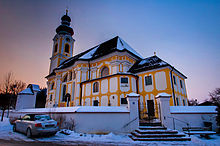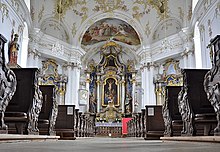Holy Cross Church (Berbling)
The Holy Cross Church in Berbling was built in the Rococo style after the middle of the 18th century . It belongs to the dean's office in Bad Aibling in the Archdiocese of Munich and Freising and celebrates its patronage on September 14th. The church, which is surrounded by a wall, is popularly known as the "Little Wies".
History and description of the building
The Berbling Holy Cross Church was first mentioned in 1315. At that time it belonged to Hofmark Berbling, which was connected to the Scheyern Monastery until the secularization of 1803 . The current church was built between 1751 and 1756 on the site of the previous building. It was donated by the Scheyern abbot Placidus Forster († 1767), who wanted to move to Berbling. He intended to develop the church into a place of grace and thereby Berbling into a place of pilgrimage .
The construction of the church was started by the builder Philipp Millauer , who probably used the plans or sketches of Kilian Ignaz Dientzenhofers as a template for the construction of the St. Adalbert Church in Potschapl in Northern Bohemia, which he built in 1724/25 . In any case, the basic shape of the two churches corresponds in many details. It is an elongated octagon , the walls of which swing inwards and which is vaulted with a dome. After Millauer's death in 1753, the construction was continued by Hans Thaller (1719–1796), who had married Millauer's widow. The consecration of the church, which was designated in 1758 , did not take place until October 4, 1789 by the then Freising Auxiliary Bishop Johann Nepomuk von Wolf , who at the same time gave 370 people the sacrament of Confirmation . The consecration was depicted by the painter Kaspar Weidtinger from Vagen on a votive plaque in the church.
The rich stucco consists of garlands of flowers, cartouches, putti, flowers, vine leaves and grapes. In the stucco there are signatures with the monograms "IR" and "IF". It is possible that IR refers to Jakob Rauch (* 1718), while IF Johann Feichtmayr or Johann Funk are suspected.
The ceiling frescoes deal with the salvific effect of the Holy Cross and thus the Berblinger cross particle. They are not signed and were probably painted by Johann Baptist Zimmermann , from whom a preliminary drawing has been preserved, and his pupil Johann Martin Heigl . The choir fresco depicts St. Helen's rehearsal of the cross , the ceiling painting depicts the battle at the Milvian Bridge and, above the organ gallery, the effectiveness of the Berblinger cross relic . Further murals can be found in the spandrels of the main room and in the vestibule.
The historicist style pulpit supplied by Johann Marggraff in 1871 was removed during the renovation in the 1940s and replaced by a simple one.
On the southern outer wall is an epitaph from 1362, which is said to have been in the previous church in front of the presbytery .
The church as well as the cemetery wall, cemetery chapel and war memorial are under monument protection .
Furnishing
The rococo high altar was probably designed by the sculptor Joseph Götsch (1728–1793) and the altar structure was made by Aiblinger Kistler Sebastian Aufhueber. The painting of the high altar with the depiction of the crucifixion of Christ is a copy of the altar panel from the Tegernsee monastery church of St. Quirin , which was painted by Johann Carl Loth in 1691 , but is no longer preserved there. The side assistant figures of Saints Josef and Joachim were delivered in 1771 by the Fröhlich sculptor's workshop in Tölz . The excerpt picture Death of St. Benedict comes from Joseph Ignaz Schilling (1702–1773). In 1786 the high altar was rebuilt by the master maker Christoph Köglsberger and supplemented with angel figures and floral decorations by Joseph Götsch. The niche of the rotating tabernacle houses a 53 cm high altar cross in front of a gold and silver background decorated with roses.
The four side altars are located in the diagonals of the church interior. The basic pattern of the two front side altars corresponds to the main altar. The approximately 50 cm high bust figures on the consoles next to the front side altars used to be used as altar decorations between the candlesticks. They are attributed to Joseph Götsch .
- Until recently the altar painting Herz Mariä by Julius Frank was in the left front side altar . After the lost Sacred Heart painting by Joseph Ignaz Schilling was found, it was put back on the altar. The excerpt with St. Augustine probably also came from him. In the lower part there is a picture of St. Francis Xavier in a rocailles frame . A guardian angel with a child can be seen in the niche of the rotating tabernacle.
- The altar painting of the right front side altar with the depiction of the Sacred Heart was created by Julius Frank, from whom the excerpt picture with St. Aloysius probably also comes. The carving in this rotating tabernacle, which depicts Saint Anne with Mary, is attributed to Joseph Götsch.
- The two rear side altars contain, in a rose-decorated palm leaf frame, copies of the Nativity ( Natus ) and Adoration ( Adoratus ) based on engravings by Peter Paul Rubens . In the excerpts the search for a hostel and the flight to Egypt are shown.
The late Gothic font made of red marble comes from the previous church. On the lid are the figures of Jesus and John the Baptist, carved from linden wood . The late Gothic cross on the right side wall is also said to come from the previous church. Opposite him is a figure of Our Lady with child .
A Lourdes grotto with a Madonna from the Munich Mayer'schen Hofkunstanstalt was built in the vestibule of the church around 1900 . Next to the grotto hangs a copy of the painting Three Women in the Church , which Wilhelm Leibl painted when he lived in Berbling from 1878 to 1881.
The late baroque Way of the Cross from 1769 was replaced in 1867 by a cycle of paintings by the Munich painter Josef Zenker . In 1946 the church was again equipped with a way of the cross in the style of the 18th century. A Stations of the Cross by the painter Weidtinger, which was copied by Benno Hilz's apprentice painter, served as a template.
reliquary
As early as the first quarter of the 18th century, the Berblingen Church received a particle of the Holy Cross from the Scheyern Monastery, which was taken from the Scheyern Holy Cross reliquary. The Berlinger Particle is located in a reliquary made of silver , which is partially gilded and richly decorated with leaf ornaments. Two angels above the stepped foot hold the cross, which is surrounded by a halo, in the middle of which is the medallion with the wood of the cross. The reliquary, which was probably made around 1722 by the Munich master goldsmith Felix Planner († 1738), is about 50 cm high.
literature
- Evelin von Rochow: Holy Cross Berbling . Kunstverlag Josef Fink, Lindenberg, ISBN 3-89870-160-3
- Dehio , Bayern IV: Munich and Upper Bavaria, Darmstadt 1990, p. 108f.
Web links
Individual evidence
- ↑ Based on the Wieskirche .
- ↑ In Dehio, Wolfgang Dientzenhofer is mentioned, probably incorrectly .
Coordinates: 47 ° 50 ′ 37.9 ″ N , 11 ° 58 ′ 20.6 ″ E



